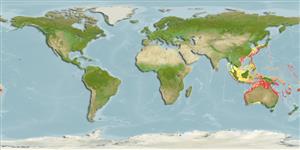>
Mulliformes (Goatfishes) >
Mullidae (Goatfishes)
Etymology: Upeneus: Greek, ypene, -es = upper lip (Ref. 45335); australiae: Named for its type locality, Australia..
Environment: milieu / climate zone / depth range / distribution range
นิเวศวิทยา
เกี่ยวกับทะเล,น้ำเค็ม สัตว์น้ำหน้าดิน; ระดับความลึก 3 - 82 m (Ref. 86942), usually 20 - 30 m (Ref. 98481). Tropical
Eastern Indian Ocean and Western Pacific: Australia and off New Caledonia.
ขนาด / น้ำหนัก / Age
Maturity: Lm ? range ? - ? cm
Max length : 16.0 cm SL เพศผู้/กระเทย; (Ref. 98481)
Short description
สัณฐานวิทยา | ความยาวต่างๆ
เงี่ยงครีบหลัง (รวม): 7; ก้านครีบอ่อนที่หาง (รวม): 9; เงี่ยงครีบก้น 1; ก้านครีบอ่อนที่ก้น: 7; สัตว์มีกระดูกสันหลัง: 24. This species is distinguished by the following characters: D VII + 9; pectoral fins 13-15; gill rakers 5-7 + 16-19 = 22-25. Adult measurements in %SL: body depth at first dorsal-fin origin 23-27 and at anus 20-23; caudal-peduncle depth 9.9-12; maximum head depth 20-22, while head depth through eye 15-18; head length 27-30; orbit length 6.0-8.0; upper jaw length 9.3-12; barbel length 16-20; caudal-fin length 27-32; anal-fin height 15-18; pelvic-fin length 20-23; pectoral-fin length 19-22; first dorsal-fin height 18-23 and second dorsal-fin height 14-18. Colouration: caudal fin with 7-13 bars in total, the upper caudal-fin lobe with 5-6 brown or black bars close to fin base, its width similar or narrower than the pale interspaces between bars; and the lower lobe with 6-8 bars of similar width as those on upper lobe, pale interspaces narrower and the 2-3 distal-most bars (one on tip) darker and wider; these caudal-fin lobe bars are mostly well-retained in preserved fish, especially on dorsal side of lower lobe; barbels are white; body and head white-silvery or pale beige, dark beige above lateral line, with a yellow-orange lateral body stripe from behind eye to caudal fin base in fresh fish; when preserved the body is pale brown and darkened dorsally (Ref. 98481).
Subadults and adults of this species occur at relatively shallow depths of the upper shelf and usually around 20-30 m (Ref. 98481). Adults feed mainly on shrimp (47%).
Life cycle and mating behavior
วัยเจริญพันธุ์ | การสืบพันธุ์ | การวางไข่ | เซลสืบพันธ์ของเพศเมีย(ไข่) | ความดกของไข่ | ตัวอ่อน
Kim, B.-J. and K. Nakaya, 2002. Upeneus australiae, a new goatfish (Mullidae:Perciformes) from Australia. Ichthyol. Res. 49(2):128-132. (Ref. 43139)
IUCN Red List Status (Ref. 130435)
Threat to humans
Harmless
Human uses
ข้อมูลเพิ่มเติม
ชื่อสามัญชื่อพ้องกลไกการเผาผลาญพลังงานผู้ล่าการศึกษาเกี่ยวกับผลกระทบของสารประกอบทางเคมีที่เป็นอันตรายต่อสิ่งมีชีวิต ประชากร และสิ่งแวดล้อมการสืบพันธุ์วัยเจริญพันธุ์การวางไข่การรวมกลุ่มวางไข่ความดกของไข่เซลสืบพันธ์ของเพศเมีย(ไข่)Egg development
อ้างอิงการเพาะเลี้ยงสัตว์น้ำประวัติการเพาะเลี้ยงสัตว์น้ำสายพันธุ์พันธุศาสตร์ElectrophoresesอัตราพันธุกรรมโรคการแปรรูปNutrientsMass conversion
ผู้ร่วมมือรูปภาพหลายรูปStamps, Coins Misc.เสียงปลามีพิษ เช่น ปลาปักเป้าความเร็วรูปแบบการว่ายน้ำพื้นที่เหงือกOtolithsสมองวิสัยทัศน์
เครื่องมือ
Special reports
Download XML
แหล่งที่มาจากอินเตอร์เน็ต
Estimates based on models
Preferred temperature (Ref.
123201): 20.9 - 28.5, mean 27 °C (based on 504 cells).
Phylogenetic diversity index (Ref.
82804): PD
50 = 0.5000 [Uniqueness, from 0.5 = low to 2.0 = high].
Bayesian length-weight: a=0.01023 (0.00593 - 0.01767), b=3.10 (2.96 - 3.24), in cm total length, based on LWR estimates for this species & Genus-body shape (Ref.
93245).
ระดับชั้นอาหาร (Ref.
69278): 3.4 ±0.0 se; based on diet studies.
ความสามารถในการกลับคืนสู่ปกติ (Ref.
120179): ความสูง, เวลาต่ำสุดที่จะทำให้ประชากรเพิ่มขึ้นเป็น 2 เท่าใช้เวลาน้อยกว่า 15 เดือน (Preliminary K or Fecundity.).
Fishing Vulnerability (Ref.
59153): Low vulnerability (10 of 100).
